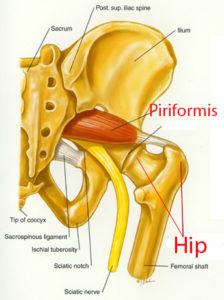Leg pain and the Piriformis Syndrome
Slipped disks, pinched nerves and misaligned vertebra or twisted pelvis are commonly associated with leg pain. The one cause that is often overlooked is the Piriformis Syndrome.
Often, when a patient presents themselves to a doctor with this kind of leg pain the examination is limited to the lumbar spine. Big mistake! The pelvis is frequently involved either directly or indirectly as a complicating factor in leg pain conditions; and this includes the piriformis muscle.
 The anatomy of the piriformis muscle is described as starting at the mid-level edge of the sacral bone in the pelvis and connects to the upper surface of each femur (thighbone). It functions to assist in rotating the hip and turning the leg and foot outward. The muscle runs diagonally, with the sciatic nerve which is located directly beneath it.
The anatomy of the piriformis muscle is described as starting at the mid-level edge of the sacral bone in the pelvis and connects to the upper surface of each femur (thighbone). It functions to assist in rotating the hip and turning the leg and foot outward. The muscle runs diagonally, with the sciatic nerve which is located directly beneath it.
Most commonly, patients describe acute tenderness in the buttock and sciatica-like pain down the back of the thigh, calf and foot. Typical piriformis syndrome symptoms may include:
A dull ache in the buttock
Pain down the back of the thigh, calf and foot (sciatica)
Pain when walking up stairs or inclines
Increased pain after prolonged sitting
Reduced range of motion of the hip joint
X-rays and other spinal imaging studies cannot detect if the sciatic nerve is being irritated at the piriformis muscle. However, diagnostic tests (such as X-rays, MRI and nerve conduction tests) may be conducted to exclude other conditions that can cause similar symptoms to piriformis syndrome.
An experienced clinician, or a spinal expert like the chiropractor can best detect this case without having to spend on all these expensive diagnostic tests; so it is best to start with the chiropractor in this situation and avoid receiving a partial or worse, a misdiagnosis or false positive test on the condition.
Home care: At the onset of pain, lie in a comfortable position on the stomach and place an ice pack on the painful area for approximately 20 minutes. Repeat as needed every 2 to 4 hours. Some people find it helpful to alternate cold with heat. If using a heating pad, lie on the stomach and place the heating pad on the painful area for up to 20 minutes. Be sure to avoid falling asleep on a heating pad, as this may lead to skin burns.
Be prepared to see the healing take somewhat longer than you think. That’s often what we see in clinical practice. Good news it that there is no need for drugs or surgery for the care and recovery of the piriformis syndrome.
Yours in Health,
docMIKE

 Follow
Follow
2 Comments
John
04/03/2017 at 4:42 pmHi doc mike as was seeking help and i found your youtube videos
I have siatic pain and had an MRI thers is this this bulge or disc extrusion doctor says.
My question is this condition can be treated thru chiropractor? Hoping for
Your kind answer. Thank you!
docMIKE
04/22/2017 at 1:24 amDear John, An extruded (ruptured) disc has a high degree of chance the material will naturally reabsorb. However, the disc is just part of the problem as the spinal joint that has been misaligned for sometime has caused the disc to become damaged. This needs attention and yes, chiropractic can help that as your extruded disc material reabsorbs over time. My experience with these situations is how surprising the leg and back pain are reduced or significantly improved within 4-6 weeks of chiropractic care. However, a full and proper chiropractic evaluation is the only way to determine if you fit the profile of someone who can benefit form our care. I will copy this message to the clinic New Patient center to assist you in scheduling an appointment. docMIKE